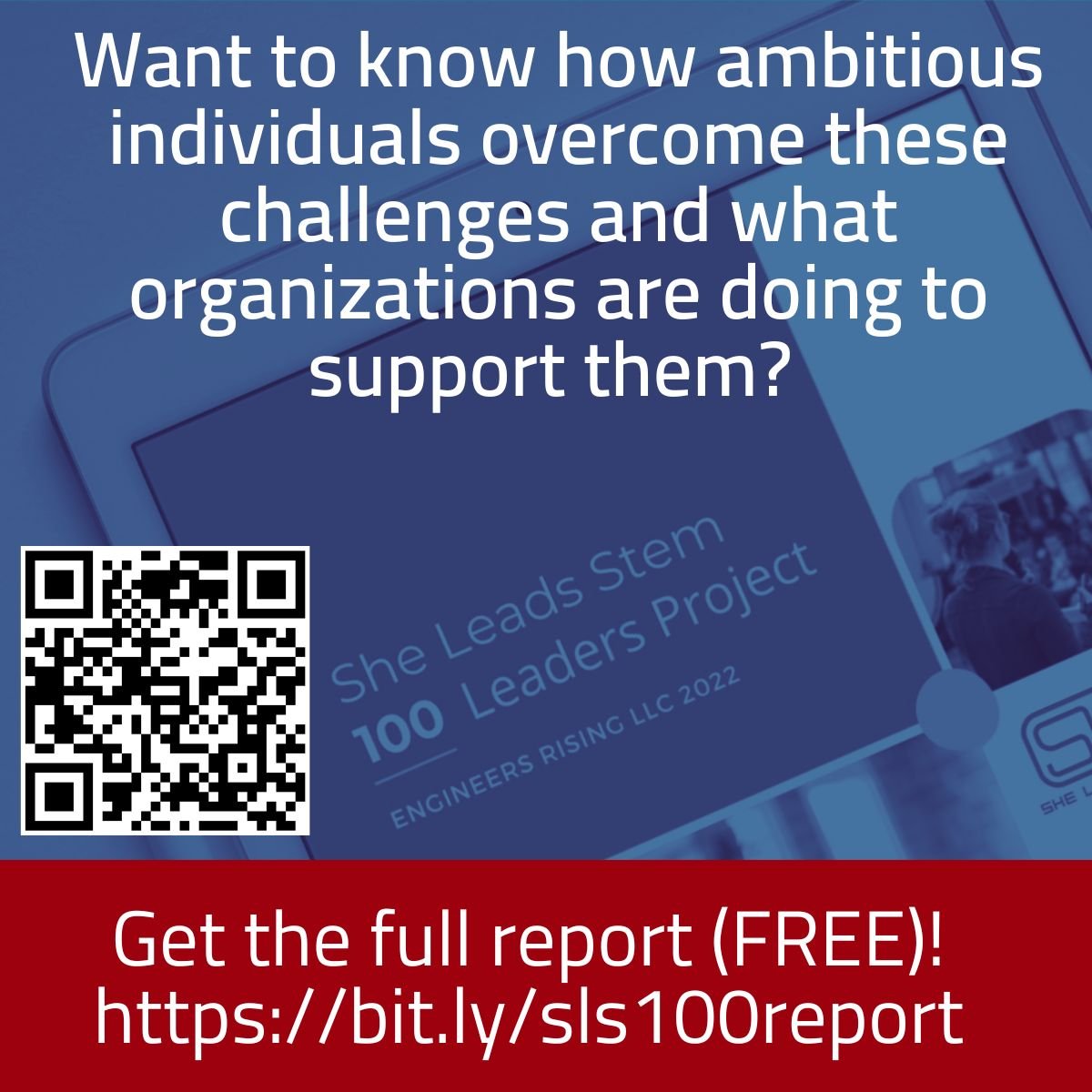Author Note: This is the first in a series of blogs based on the She Leads STEM 100 Leaders Report. What you'll read in this blog is a small snapshot of the data available. Sign up to access the FREE report here: https://bit.ly/3Ne4e2A
Every STEM professional knows that the beginning of solving a problem is to define it. Only once we identify and understand specific challenges can we start moving towards solutions.
For a quick snapshot of the retention challenges women in STEM face:
40% of women engineers leave or never enter the field; that number has not changed significantly in the last two decades
1 in 4 women leave engineering specifically after age 30 (compared with 1 in 10 men; we don't have data on LGBQT+ individuals)
More statistics are available HERE in my blog and throughout She Engineers (with a future blog to include a compilation of them).
During my interviews of more than 100 women emerging and current STEM leaders and allies, I asked them to share in their own words:
Why do you think there aren't more leaders like you? What do you think is holding women back, given that the massive increase we've seen in female STEM graduates in the last two decades has not generated a similar increase in women working in these fields?
While each interviewee had a unique perspective, ten comment themes emerged from the answers to this question.
1. Unconscious Biases
Our brains are wired to make snap judgments as a survival mechanism. These judgments can be positive or negative and influence our behavior towards others. Unconscious biases are often related to gender, race, age, and other identity features that have nothing to do with how good we are at our jobs. Examples include:
Women are less technically competent (i.e., good at math and problem-solving) than male colleagues.
Women excel at administrative and community-building tasks; this manifests at work with "office housework," such as taking notes during meetings.
Parents are not as committed to their positions if they have children.
Older people don't pick up technology as quickly as someone younger.
Whatever the unconscious bias is, it's important to remember that it's unconscious—it's not an intentional thought! Despite this, they can seriously impact how we interact and work with each other in the workplace. Women in STEM face unconscious biases that influence their upward career trajectory or leadership opportunities.
2. Lack of Workplace Flexibility
Flexibility in the workplace refers to policies that support employees' personal lives. For example, work-from-home policies, parental leave, and bereavement leave all support and care for employees as people. Types of leave may include sabbaticals, time off, and flexible daily or weekly work schedules.
Some STEM organizations have these policies, but many lag behind the needs of the modern workforce. My interviewees shared that despite work-from-home and flexible workplace policies becoming more normalized because of the pandemic, some organizations have a stigma around using them. To increase retention and employee satisfaction, employers need to:
Offer flexible benefits
Normalize personal days and reduce stigma surrounding policies
De-couple productivity from the use of flexible work policies
Encourage leaders (especially leaders who are NOT women and non-binary individuals) to model the use of flexibility benefits
3. Hustle Culture
A work culture valuing hours worked and "butts in seats" also emerged as a challenge. Many organizations still measure "productivity" by hours worked and how visible individuals are to management (also known as “proximity bias”).
Research outside of my case study has debunked the mindset that working more hours equals productivity (Google it if you don’t believe me). Yet, work cultures have been slow to move to a more performance-based environment that prioritizes results and outcomes over hours worked and visibility.
Many of the STEM leaders I interviewed were frustrated by colleagues expecting them to "pay their dues" through long hours before reaching the next step in their leadership journey.
4. Unclear Promotion Paths
For women to advance in their STEM career paths, there needs to be a clear, defined path for career growth. In many STEM organizations, promotion paths are a mystery. Because as humans we gravitate towards people “like us” unconsciously, in the absence of written and objective promotion criteria, women and others who don’t match existing organizational leadership styles are left out of promotion discussions.
Examples of ways employers can fight that unconscious bias, as shared by interviewees, include:
Define objective criteria for promotions.
Communicate criteria to all employees.
Include more than one decision-maker in the promotions process, preferably at least one individual who can be more objective because the person promoted is NOT reporting directly to them.
Be transparent and clear during the promotional process.
5. Minimal Mentorship and Sponsorship for Women
Mentorship, coaching, or sponsorship is one of the best ways to progress toward leadership roles. The number one event that foreshadowed an individual's rise into a leadership position was a “mentorship moment.”
Curious as to the difference between mentorship and sponsorship? Mentorship is career advice given with "no skin in the game" from the mentor. In other words, the mentee receives career advice with little further support from the mentor beyond that advice. Sponsorship is the active support of an individual when they are not in the room and often requires exertion of the mentor's professional influence and reputation.
The vast majority of those I interviewed did NOT differentiate between the term "mentorship" and "sponsorship" in the interview. Instead, I asked interviewees to share their stories and the moments where support made a difference in their careers. Many interviewees described behaviors of "mentors" that matched the definition of "sponsors."
It is also notable that those with accelerated leadership rises in their organizations universally described sponsorship-like behaviors of their mentors. Skillsets for accelerated leadership rises will be the topic of a future blog.
Interviewees viewed the lack of mentorship, sponsorship, and general lack of senior-level women leaders as a significant challenge. Those who cited this challenge noted that even when they have been able to find mentors, they had to work harder and be more proactive to cultivate those relationships in a way their perceived their male colleagues did not.
Just 18% of people I interviewed had direct contact and mentorship from a high-ranking woman in leadership. That means that the vast majority of mentors tend to be males. This is a critical insight for organizations and those looking for mentors: senior male allies MUST play an outsize role in mentorship to shift the needle more rapidly on women's retention in STEM.
6. Institutional Racism and Sexism
Many interviewees brought up experiences they had in workplaces that demonstrated institutional racism and sexism. Unlike unconscious biases, which are usually unintentional, many of these experiences showed up as intentionally discriminatory and harassing behaviors by someone who wanted to maintain power over them.
Unfortunately, institutional racism and sexism are still common in many STEM organizations; I reported the disheartening statistics on the prevalence of harassment and discrimination against women in male-dominated workplaces in THIS Medium post.
Institutional racism and sexism do not just hold women in STEM back from leadership opportunities; it directly leads to leaving STEM fields entirely. We need to recognize it exists and stop it in its tracks. Allies (i.e., the person NOT experiencing sexism and racism) play the most significant role in preventing and stopping unacceptable behaviors and holding perpetrators accountable.
7. Gender Pay Gap
The prevalence of the gender pay gap has been well-documented in research outside my case study interviews; it was further confirmed through my interviews. One notable trend was that some women and non-binary STEM leaders only realized they were underpaid when they became responsible for hiring employees! Though the situation was typically rectified once brought to light, it highlights that the gender pay gap is still a challenge. Interviewees in leadership positions commented that one "best practice" for those managing payroll is to review data annually to verify there are no gender differences in pay for similar roles and experience levels.
8. Not Speaking Up
Many interviewees recounted stories and experiences mentoring younger women and encouraging them to speak up. Some of the senior women noted that they'd observed gender differences regarding the willingness of young professionals to speak up confidently and ask for what they wanted at work.
The most senior leaders interviewed had similar advice: Speak up, ask for what you want, act confidently, and use your voice.
Is this biased-based advice? Of course! We know being more or less outspoken has nothing to do with your ability to do your technical work. However, it is the reality that in many STEM workplaces, speaking up is critical for advancement (for all genders). The women leaders I interviewed reported that "self-advocacy" was a critical skill set they developed that led them to their current leadership position.
9. Poor Communication
There was a subset of interviewees that noted they did not see specific gender issues as being a challenge for emerging women leaders. For those interviewees and anyone who reported a negative past experience with a manager, poor communication was cited as a significant barrier to leadership. Examples from my interviews include:
Communication style clashes
Lack of clear direction on tasks
Unclear prioritization of tasks or competing priorities
No constructive feedback
Undermining, dismissive, or sexist comments/”jokes”, especially in a team or group setting
Poor communication holds everyone back from STEM leadership opportunities because it creates confusion and requires extra effort to "figure out" expectations and what someone meant when they communicated. Lack of clarity surrounding what success looks like in a role, office promotion policies, and available leadership opportunities make it hard to advance. Clear communication of expectations and regular feedback are two ways cited by those I interviewed to support more women advancing into STEM leadership.
10. Lack of support
The interviewees identified two specific areas where they faced a lack of support: workplace flexibility policies and professional development. Many interviewees had changed roles or organizations because they did not have any support for their growth in their career path and journey.












The ten challenges I shared above are excerpts from data I collected from interviews of more than 100 women emerging and current STEM leaders and allies. I wanted to answer the more significant question: What have those leaders done to be successful, and what are organizations doing to support them?
The challenges above are a tiny portion of the report, which focuses on solutions to these challenges. Look for future blogs where I share more information about those solutions!
In the meantime, if you don’t want to wait or want to see all the data in the case study, click here to get a free copy of the entire white paper. There’s even an audio reading by me for on-the-go listening.
By better understanding women in STEM challenges, we can keep fighting for improvements and progress. Now I'd like to know in the comments—what do YOU think is the biggest challenge in seeing more women in STEM leadership?



